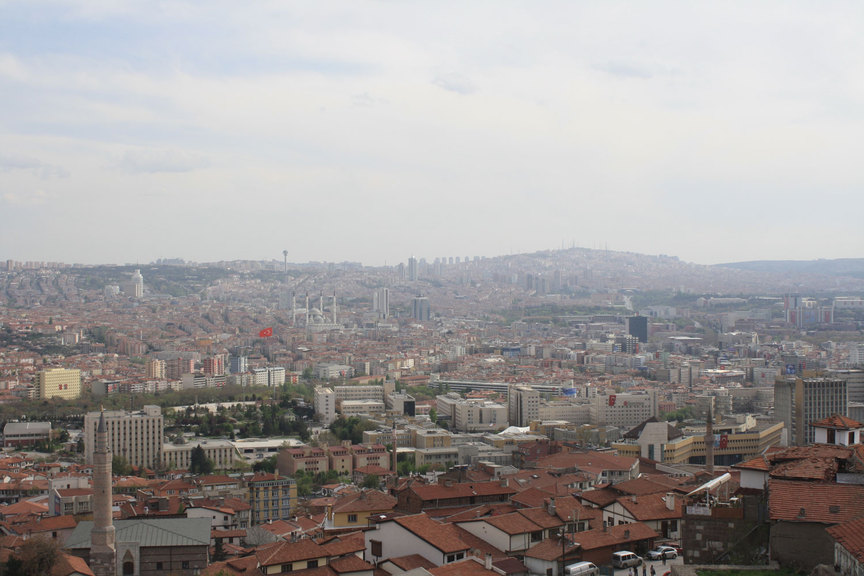High on the Anatolian plateau (at nearly 850 meters above sea level), with a population of under five million, Ankara was declared the Turkish capital in 1923. At the time only 75,000 people lived there, so most of the city has been built since and it continues to expand in all directions.
Anıtkabir, the neo-classical mausoleum of the state’s founder Mustafa Kemal Atatürk (1881–1938), was completed in 1953. A testament to the Kemalism—a modernizing, secular and nationalist vision for Turkey—Anıtkabir is notable for its lack of references to Islam or the Ottoman Empire, and instead draws inspiration from the ancient Hittite and later Roman cultures of Ancyra.
As a great military general who led Turkey to defeat the Greeks in the War of Independence, Mustafa Kemal was dubbed Atatürk (meaning, “Father of the Turks”). This anonymously painted portrait of Atatürk on horseback, displayed in Anıtkabir, is typical of the personality cult that the Turkish state created around its founder in the 20th century.
Many German and Austrian architects, some members of the Third Reich, others refugees, including Jews, fleeing the Third Reich, worked as architects and urban planners in 1930s Ankara. Here, the Bauhaus influence is plainly evident, though this building (now, a women’s technical high school), designed by Austrian-Swiss architect Ernst Egli, is considered a prime example of Turkey’s “New Architecture.”
The exterior of the Resim ve Heykel Müzesi, the State Museum of Painting and Sculpture, originally designed by Arif Hikmet Koyunoğlu as a concert hall, but converted into the art museum in museum in 1980. Adopting the traditions of European culture—including fine arts—was a central aspect of early Kemalism.
Grand foyer of the Resim ve Heykel Müzesi, the State Museum of Painting and Sculpture.
Paintings line the walls of the museum, in a roughly chronological fashion (few paintings have dates). There are no wall labels, only small plaques on the frames with the artist’s name. Each gallery is named after the most famous artist on view. Many paintings are crooked and dusty.
The styles on view range from figurative realism and landscapes, to more modernist depictions of Anatolian culture, as well as experiments in abstraction.
Poorly (if at all) curated, the museum is also a kind of treasure chest. Unfortunately, it is one that is susceptible to looting. A 2010 Tourism and Culture Ministry inventory revealed that more than 300 paintings had been stolen from the museum’s collection and sold to private collectors—30 works were recovered in December, mostly in the warehouses of Istanbul auction houses.
A detail of a landscape by Devrim Erbil, one of a few still-living artists whose work is in the museum.
The exterior of SALT Ulus—a small residential building adjacent to the Ottoman Bank that hosts exhibitions and programs on its two floors.
The current show is an adaptation of “A Promised Exhibition,” a retrospective of Gülsün Karamustafa first shown at SALT Beyoğlu and SALT Galata, Istanbul, in September, 2013. Here, the installation of Monument and the Child (2011) is installed in the street-level gallery.
A wall of Karamustafa’s collages and drawings from the 1980s depicting Turkey’s arabesque and popular culture.
The original Galeri Nev is located in Ankara (its more prominent branch is now in Istanbul) and is celebrating its 30th anniversary.
The interior of Galeri Nev, in preparation for a celebratory group exhibition.
Ankara’s Siyah Beyaz (“Black White”) gallery was also established in 1984. Its foyer is covered in invitations to past exhibitions.
Appropriately enough, the gallery space is all black and white.
Downstairs in their project space, Siyah Beyaz hosted young artist Ayşegül Turan’s sculptures in “26 Fe.” Her pieces explore the physical properties of magnetism.
In the building’s subterranean floor, Siyah Beyaz has its own nightclub. Its walls are covered in black-and-white photos and it often hosts live music acts.
The interior of the local artist-run nonprofit Torun, with works by Ankara-born, Istanbul-based multimedia artist Volkan Şenozan (photo courtesy of Duygu Demir).




